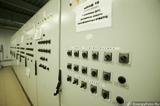What is relay protection for?
 The design and operation of any electrical system must take into account the possibility of failures and abnormal modes of operation in it, which can lead to breakdowns in the system, accompanied by a shortage of electricity for consumers, unacceptable deterioration of its quality or destruction of equipment .
The design and operation of any electrical system must take into account the possibility of failures and abnormal modes of operation in it, which can lead to breakdowns in the system, accompanied by a shortage of electricity for consumers, unacceptable deterioration of its quality or destruction of equipment .
Prevention of an accident or its development can often be ensured by quickly shutting down the damaged element. Under the conditions to ensure continuous operation of the undamaged part of the system, the time to turn off the damaged element must be short, often amounting to a fraction of a second.
It is quite obvious that a person servicing the installation is not able to notice the appearance of a fault and fix it in such a short time. Therefore, electrical installations are equipped with special electrical machines — protective relay.
The purpose of relay protection is to disconnect as soon as possible the damaged element or section of the power system from its undamaged parts….If the failure does not threaten the immediate destruction of the protected object, does not disrupt the continuity of the power supply and does not pose a threat to the safety conditions, then the protective devices can act not for shutdown, but for a signal alerting personnel on duty to the malfunction.
Relay protection devices must operate in the event of a signal or interruption and in the event of abnormal operation of the network, if such modes may pose a danger to the equipment.
Relay protection requirements
Relay protection is subject to the following selectivity, sensitivity, speed and reliability requirements:
1) Selectivity of action (selectivity) — the ability of the relay protective device to work in the event of a fault in the zone of its action and not to work in case of external faults and load modes, i.e. selective is called such a protective action in which it switches off only the damaged element with the help of its circuit breakers. All other parts of the system must remain on.
All relay protection devices are divided into 2 classes in terms of selectivity:
- relative selectivity protection — selectivity is provided by the choice of response parameters. These include overcurrent and distance protection;
- protection with absolute selectivity — selectivity is ensured by the principle of action — all types of differential protection.
Read more about it here: What is the selectivity of protection in electrical installations
2) Sensitivity - the ability of the relay protective device to respond to the minimum values of the alarm parameters.
For example, if a fault occurs on high-voltage lines operating at minimum loads and high fault transients, the short-circuit currents may be lower than the maximum load currents. This leads to the impossibility of using conventional current protection and forces you to switch to more complex and expensive types of protection.
The sensitivity of protections is evaluated sensitivity coefficient... For protections that respond to increasing values in the event of a fault (for current — current): k = Ikzmin / AzWednesday, where: Azkzmin — value of the current in case of a short circuit of the metal in the protected area; Azcf is the current setting for triggering the current protection.
3) productivity — is determined by the following considerations:
- Faster fault interruption increases the stability of the parallel operation of electrical machines in the system and therefore eliminates one of the main causes of the most severe system faults.
- Acceleration of trip failure reduces the time consumers operate at reduced voltage, which will allow electric motors to remain in service for both consumers and their own power plant needs.
- Accelerated damage clearance reduces the damage amount of the damaged item.
Therefore, for 500 kV power lines, the speed should not be worse than 20 ms, 750 kV — 15 ms.
4) Reliability - the ability of the relay protection device to perform the specified protective functions for a specified time under specified operating conditions.
Also read on this topic: Microprocessor-based relay protection devices: overview of possibilities and controversial issues
